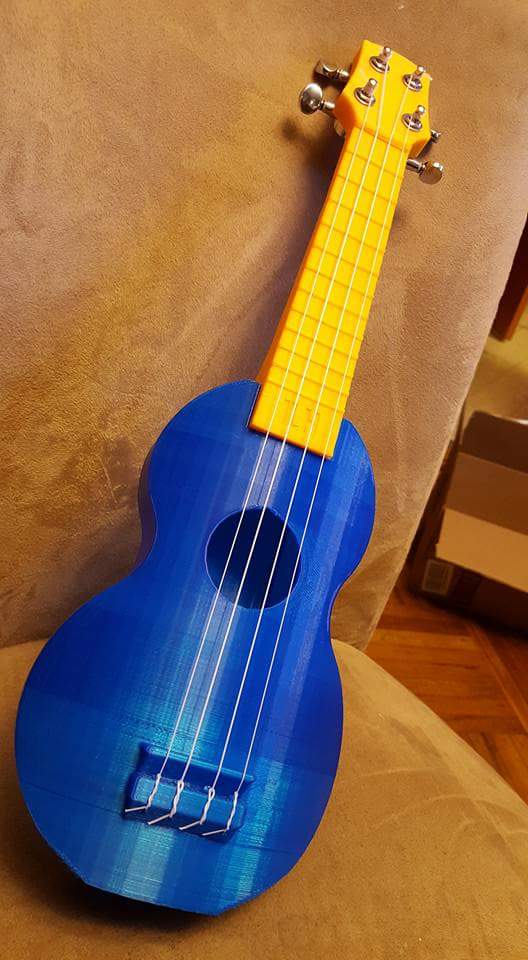Is there a way to increase the resolution quality of an stl file. I printed a beautiful ukulele from thingaverse but you can notice the curve isn’t rounded perfectly. Are stl files vector? Also what does one do if they want to enlarge an stl file and keep quality?
My kid does something in Blender, subdivision maybe? He’s taken STL files I give him and smoothed out curves and surfaces somehow. Magic, I tell ya.
There are ways to convert them back and do some editing, but… if the 3D model is an apple, then an STL is applesauce. So, you have a lot harder time doing alterations to the model with only the STL.
Stl files are based on triangles - so think “vector” without “spline”. As there is no pixel (or voxel) “resolution” per se, scaling won’t degrade the model in any way, but you will, of course scale each triangle accordingly.
One way to smooth the model would be through Blender’s subdivide tool - but keep in mind that will also smooth out sharp corners unless you mask them.
STL files aren’t vectors, they’re a surface made up entirely of triangles. The easiest way to do what you want would be to get the source CAD file of the object then scale it up within the CAD program and export it as an STL. Or, alternatively, define a higher minimum polygon count when you export it to STL to get a smoother surface.
But if you don’t have the original source file you can try subdividing the mesh to increase the number of polygons, then applying smoothing algorithms to make the curve smoother, then reducing the polygon count back down to a point where the file isn’t massive and unwieldy but still gives you the detail you want.
I’m not sure how successful you’re likely to be with that, or exactly what program would be the best to try that in, but as a general matter that would be how I’d approach it.
STL files are not vector graphics. They use triangles to approximate the surfaces of the model.
you can try meshlab (probably easier to use than blender, and much much lighter as an application for a simple job).
Now once again, you would only interpolate the angles, and not add information to the file instead, just like doubling the size of a given jpg makes it smoother, but you lose sharpnes. So in 3d this is OK for potatoes, but very ugly for an Effeil tower.
Check the web, there are numerous tutorials for that 
What printer do you have that prints so big?
FWIW, I do mashups to “correct” things I don’t like about other people’s STLs all the time. For me, I import the STL into OpenScad, then I use OpenScad declarations to erase, replace, reorient, add to, etc. I don’t know if you can do the same thing in TinkerCAD, et. al., but presumably in some of those environments you should be able to.
In this particular case, I would worry about changing the acoustics of the thing, however–if you modify the curve but make a thicker wall, say, in the process, what effect will it have on the instrument?
You can smooth it in Blender, using subdiv.
STL files can contain either triangles or quads, and if you want to use subdiv in Blender without crying too much, you will want to convert to quads.
Fortunately Blender has this built in, so the job should not be too onerous. If you are stuck, you can contact me via my website http://daniepstein.com and I will point you in the right direction.
Suffering from momentary drain bamage currently, but I believe that the free and slightly easier to use than blender program Meshmixer also has the ability to increase the mesh allowing for smoother curves when scaling up.
Meshmixer can smooth meshes, but in this case will probably destroy the sharp edges where you actually need them.
I’ve had pretty good luck using the face groups command and selecting only those that don’t break the edges. Sometimes things can get out of hand in an incomprehensible manner, though. I like Blender too, but forget about ninety percent of the sequences needed to accomplish something. I’d like to get a memory upgrade from Crucial.com but they don’t do androids.
Meshlab is able to smooth surfaces and keeping edges. You just have to play around with the parameters how Meshlab detects the geometry. I would also suggest to copy your original geometry to another layer first because there is no undo button in Meshlab. 
Meshmixer will definitely do it:
- Select entire model-
- remesh with linear subdivision once or twice to add in more geometry
- paint select where you want to smoot
- Deform --> Smooth
(or use sculkpting tools as well)
Try this http://airwolf3d.com/2014/10/22/smoothing-stl-file-sketchup-blender-3d-printing/ It isn’t perfect but may help.
Just had a quick go at sorting this out in Blender - stuff of nightmares! You would have to remodel the whole thing. Easiest to contact the designer and ask them to export a high-res mesh, which presumably you have done already, but there you have it.
Aha! It was even easier than I thought! I downloaded the ukulele from Thingiverse and did this in Meshmixer:
- Select button on left
- Ctrl-A to select entire mesh
- Edit -> Remesh -> Linear Subdivision at 50% with Sharp Edge Preserve checkbox turned on
- (now another remesh command) Edit -> Remesh -> Adaptive Density (to whatever % you want) with Sharp Edge preserve still turned on
- Done!
(NOTE: that still does not fix the egregious errors in the mesh…only a “Make Solid” command did that for me)
